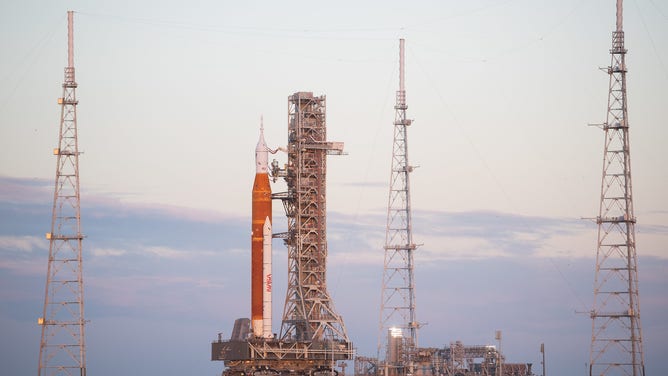NASA delays Artemis 1 launch as Hurricane Nicole approaches Florida
NASA is now targeting Nov. 16 at 1:04 a.m. to launch the Artemis 1 test flight from Florida. Nicole's latest forecast is within the margin the SLS rocket is certified to withstand of winds up to 85 mph, according to the space agency.

NASA’s Space Launch System (SLS) rocket with the Orion spacecraft aboard is seen atop the mobile launcher as it arrives at Launch Pad 39B, Friday, Nov. 4, 2022, at NASA’s Kennedy Space Center in Florida. Photo Credit: (NASA/Joel Kowsky)
(NASA)
KENNEDY SPACE CENTER, Fla. – Ahead of Hurricane Nicole's arrival to Florida, NASA has decided to delay its next attempt to launch the Space Launch System moon rocket giving teams more time after the storm.
The space agency was targeting Nov. 14 to launch the SLS and Orion spacecraft on the test flight known as the Artemis 1 mission around the moon. With the rocket vertical on the launchpad and an impending tropical storm heading toward Florida's east coast, NASA announced it would hold off and use one of the backup launch dates later in the week.
NICOLE TRACKER: PROJECTED PATH, WATCHES AND WARNINGS, STORM SURGE, WINDS RAINFALL TOTALS AND MORE
NASA is now targeting Nov. 16 during a two-hour launch window opening at 1:04 a.m. to launch the uncrewed test flight from Florida. Under this timeline, Orion will complete the mission with a Pacific Ocean splashdown on Dec. 11.
Earlier this week, NASA managers decided to leave the 322-foot-tall rocket at the launchpad instead of rolling it back into the Vehicle Assembly Building ahead of the storm.
This marks the second tropical system to delay NASA's moon mission. The rocket was awaiting another launch attempt in September when Hurricane Ian forced the space agency to move the SLS back into the hangar.
According to the FOX Forecast Center, Hurricane Nicole will approach the east coast of Florida, making landfall on Wednesday night or early Thursday. Nicole is forecast to reach Category 1 strength when it makes landfall near the Space Coast with winds of at least 74 mph.
WHAT IS NASA'S ARTEMIS 1 MISSION GOING TO DO?
NASA said the forecast is within the margin the SLS rocket is certified to withstand.
"Current forecasts predict the greatest risks at the pad are high winds that are not expected to exceed the SLS design," NASA wrote in a blog post. "The rocket is designed to withstand heavy rains at the launch pad and the spacecraft hatches have been secured to prevent water intrusion."
According to NASA, the SLS can remain at the launchpad with peak winds up to 74.1 knots (85 mph) at 60 feet up.
Tropical Storm Nicole continues to intensify
Tropical Storm Nicole continues to intensify with maximum sustained winds of 65 mph. Strong winds and coastal flooding are likely along the East Coast. Nicole is expected to reach hurricane strength by Wednesday evening.
Early this week, Kennedy Space Center staff were preparing for the incoming storm.
Under HURCON II status, the Center is preparing for 50-knot (58 mph) sustained winds within 24 hours. Neighboring Cape Canaveral Space Force Status is also under HURCON II.
Ahead of Nicole's arrival, NASA engineers powering down the Orion spacecraft, SLS core stage, interim cryogenic propulsion stage and boosters.
After the worst of Nicole's impacts passes, engineers will need to inspect SLS, Orion and the launch facility for any damages.
There is an additional backup launch date on Nov. 19 at 1:45 a.m.
When it happens, this will be the third attempt to launch the Artemis 1 mission. Two earlier attempts this summer ended in scrubs due to technical issues.
